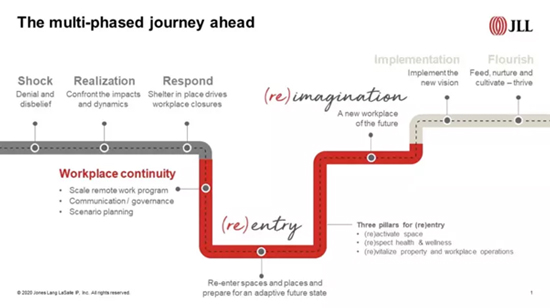The future of office space post COVID-19


Change is the only constant.
We’ve all heard the saying multiple times in multiple contexts. But it fits perfectly for the current situation when everything is changing so fast around us with the pandemic and its after-effects. This is especially true for workspaces which is witnessing one of the most drastic changes so far.
According to a Deloitte study, approximately 2.7 more than four out of five workers have been affected by the COVID-19 lockdown worldwide. The offices shut down and people were, some still are, working from home. Like with every other challenge, companies are planning to evolve and emerge with some new, some old strategies to combat this situation. The leaderships worked to rise up again and bring a new outlook to workspaces, a more safer and people-friendly approach.
So how does the future workspace look like post the COVID-19 era? Does this change anything? Or will people carry on with the business as usual? Let’s find out.
- Physical offices
A CBRE report states that the relevance of physical office spaces is not going to diminish. 38% of people believe that it will still remain important, with 41% of people hinting that its importance will decrease only slightly.
But why? Hasn’t the lockdown acquainted people with working from home?
It’s hard to conclude. Initially, as the pandemic hit hard and the entire world followed a lockdown, it was believed that this will definitely change the need for physical office spaces. People started working from home and got accustomed to it pretty quickly. This seemed to be the easier option for most. But soon, they got weary of working from home. Workplace Insight reports that people realized that the key components of office life were missing, impacting productivity, socialization, direct collaborations, and informal communications. They needed a separate workplace than their home office. That might be the reason people are wanting to go back to their offices when they feel safe.
- Long-term strategy
In spite of businesses and markets taking a toll, people are quite confident that the economy will stabilize and so will the commercial real estate industry. The CBRE study shows that almost 70% of people are still aiming for long-term real estate strategies. The real estate industry is hopeful that the confidence will build over the next six to twelve months. Leaders are weighing different options, with their pros and cons; for instance, a distributed workforce can reduce the health risk but it comes at a cost of affecting the corporate culture and connectivity. Similarly, multiple locations may ease down the commute for people but it involves greater capital and operating cost.
If anything, occupiers are taking this situation as a learning opportunity to observe and analyze the existing gaps and take these learnings as guiding steps for future strategies.
- Flexible office space
Considering the incoming of different unknown people, flexible workspaces were considered as risk zones for the virus to spread. As a result, the fast-growing flexible office space market slowed down due to COVID-19. But owing to the delays in construction currently, flexible working spaces are considered as a temporary fix for the offices or as an alternative to working at-home. Flexible spaces offer the best combination of no capital commitment and no risk of having an unwanted space, which is the need of the hour for most occupiers. 73% of people who participated in a CBRE study claim that flexible office space will be a part of their long-term real estate strategy.
- Portfolio adjustments
The industry is going through a lot of introspection and subsequent changes. Here’s another finding from the CBRE study which further reinstates the fact. More than 60% of occupiers are pursuing lease renewals and over 50% have put their relocation plans on hold. Further, more than 85% are optimizing their portfolios regarding remote working, urban and suburban locations, and how flexible office space plays a part in their plans. 75% of them have either their expansion plans on hold or cancelled. It will be interesting to see how the times ahead turn out for the industry.
The Way Ahead
To portray the way ahead for office spaces, JLL has curated the route, from how the industry reacted to the pandemic in the initial phase to how the offices will adapt to it. This journey quite accurately describes the whole situation and how the upcoming times will see an advanced office space with well-thought visions.

A Cushman and Wakefield article states that the new normal will be the one that has a Total Workplace Ecosystem. From one particular office location, organizations will move to an ecosystem that includes a variety of locations and experiences to support convenience, functionality, and wellbeing. The office space will evolve from simply providing a place to work to an inspiration that strengthens cultural connections, learning, bonding with customers and colleagues, and supports innovation.

